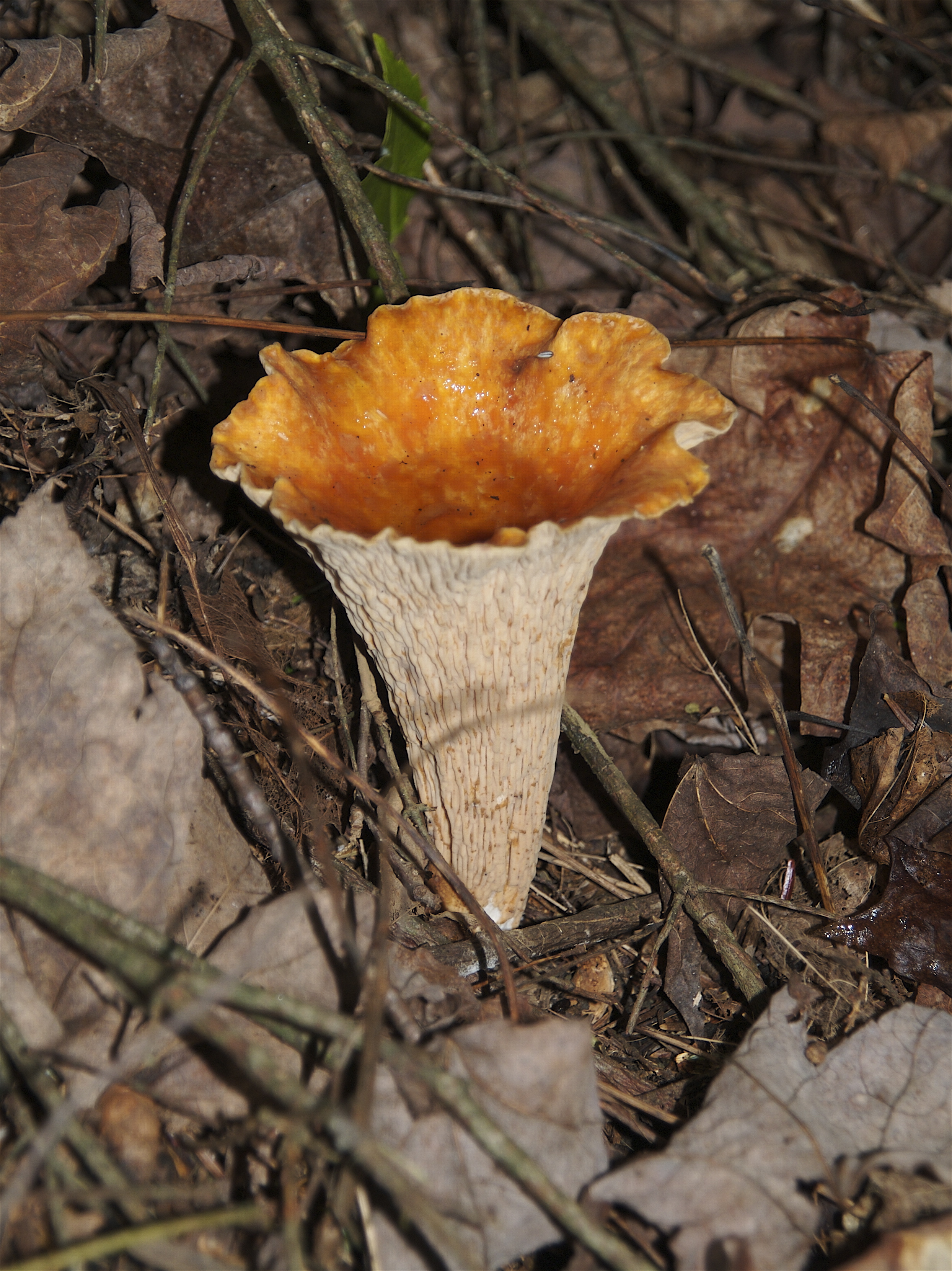- Gomphus floccosus
Taxobox
name = "Gomphus floccosus"

image_caption = "Gomphus floccosus"
regnum = Fungi
divisio =Basidiomycota
classis =Agaricomycetes
ordo =Phallales
familia =Gomphaceae
genus = "Gomphus"
species = "G. floccosus"
binomial = "Gomphus floccosus"
binomial_authority = Schw. (Singer)mycomorphbox
name = Gomphus floccosus
hymeniumType=ridges
capShape = infundibuliform
whichGills = decurrent
stipeCharacter=bare
sporePrintColor=brown
ecologicalType=mycorrhizal
howEdible=poisonous"Gomphus floccosus", sometimes known as the shaggy-, scaly-, or woolly chanterelle or woolly gomphus, is a cantharelloid mushroom. The genus has been determined to be
polyphyletic , which will more than likely lead to this species being renamed in the future. It forms ectomycorrhizal relationships with various types of conifer; fruiting bodies may be found in coniferous woodlands across Eastern Asia, from Korea to Pakistan, and in North America, more frequently in the west, in late summer and autumn. The orange-capped vase- or trumpet-shaped fruiting structures may reach 20 cm (8 in) high and 15 cm (6 in) wide; though mild tasting, they cause gastrointestinal symptoms of nausea, vomiting and diarrhea when consumed.Taxonomy
"G. floccosus" was first described in 1832 by American mycologist
Lewis David de Schweinitz as "Cantherellus floccosus", but in 1945 it was transferred to "Gomphus" by Singer. Its specific epithet is derived from theLatin "floccus" 'flock of wool'. [cite book|author = Simpson DP| title = Cassell's Latin Dictionary | publisher = Cassell Ltd.| date = 1979|edition = 5|location = London|pages = 883| isbn=0-304-52257-0] The generic name is derived from theAncient Greek 'γομφος' "gomphos" meaning 'plug' or 'large wedge-shaped nail'. [ cite book|author=Liddell HJ, Scott R|year=1980|title=Greek-English Lexicon, Abridged Edition |publisher=Oxford University Press, Oxford, UK|id=ISBN 0-19-910207-4] An alternate combination of "Turbinellus floccosus" was proposed by Earle in 1909.Description
Adult fruiting bodies are trumpet- or vase-shaped with a scaly cap 5-15 cm (2-6 in) in diameter and colored various shades of reddish- to yellowish-orange. The spore-bearing undersurface is irregularly folded or ridged rather than gilled and is pale buff or yellowish to whitish in color. The height of the fruiting body is around 8-20 cm (3-8 in), and there is no clear demarkation between cap and stalk. The spore print is brownish, the spores ellipsoid with dimensions of 12.4-16.8 x 5.8-7.3 μm.cite book |last=Ammirati |first=Joseph F.|coauthors= James A Traquair and Paul A Horgen |title=Poisonous mushrooms of the northern United States and Canada |year=1985 |publisher=University of Minnesota Press |location=Minneapolis |isbn=0-8166-1407-5 |pages=253-54]
Distribution and habitat
The fungus appears to form ectomycorrhizal relationships with various conifers including
Douglas-fir ("Pseudotsuga"),fir ("Abies"),Pine ("Pinus") and Western Hemlock ("Tsuga heterophylla "). Fruiting bodies may be found in coniferous forests in North America, particularly the western states in late summer and autumn. They are most abundant in rainy parts of thePacific Northwest .cite journal |last=Petersen |first=DH|year=1971|title=The genera "Gomphus" and "Glococantharellus" in North America |journal=Nova Hedwigia |volume=21|pages=1–118] It also occurs through Asia, having been recorded from Korea, China, Tibet, Nepal, India, and Pakistan.Toxicity
Consumption may result in nausea, vomiting and diarrhea. The onset may be delayed by up to 8-14 hours. A compound known as α-tetradecylcitric acid (norcaperatic acid) has been isolated from this species and may be the toxic agent. [Ammirati "et al." p. 252]
References
External links
* [http://healing-mushrooms.net/archives/gomphus-floccosus.html “"Gomphus floccosus"”] by Robert Sasata, "Healing-Mushrooms.net", June, 2008.
Wikimedia Foundation. 2010.
